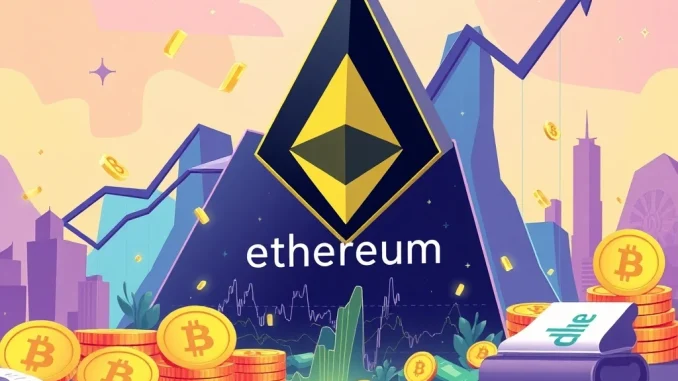
Get ready for a seismic shift in the crypto landscape! Ethereum, the world’s leading smart contract platform, is on the cusp of a monumental surge in Ethereum institutional demand. This isn’t just speculation; it’s a confluence of groundbreaking U.S. crypto legislation, the imminent arrival of Ethereum staking ETFs, and a significant shift in market dynamics evidenced by the rising ETH/BTC ratio. If you’ve been watching the crypto markets, you know that regulatory clarity and institutional adoption are the holy grail for sustained growth, and Ethereum is now at the forefront of this evolution.
How Are New US Crypto Laws Fueling Ethereum Institutional Demand?
The recent passage of new US crypto laws, specifically the Genius Act and Clarity Act, marks a pivotal moment for the entire digital asset ecosystem, but particularly for Ethereum. These legislative measures have brought much-needed regulatory clarity, especially concerning stablecoins and tokenized assets, the vast majority of which reside on the Ethereum network. For years, institutional investors have shied away from the crypto space due to regulatory ambiguity, but that era is rapidly drawing to a close.
This newfound clarity has dramatically bolstered confidence in Ethereum’s robust ecosystem. Traditional financial institutions, from asset managers to investment banks, are now more comfortable integrating Ethereum-based products into their portfolios. This isn’t just theoretical; we’re already seeing concrete evidence:
- Increased Open Interest: A remarkable $6 billion increase in open interest on derivatives exchanges highlights growing institutional participation.
- Record CME Futures Volumes: The Chicago Mercantile Exchange (CME) has seen unprecedented volumes for Ether futures, a strong indicator of professional investor engagement.
- Significant ETP Inflows: Ether Exchange Traded Products (ETPs) have attracted a staggering $2.1 billion in inflows, showcasing a clear preference for regulated investment vehicles.
- Strategic Acquisitions: Major players are making direct moves. For instance, the Ether Machine and Dynamix Corp SPAC merger led to the acquisition of 400,000 ETH. Similarly, Bit Digital’s strategic conversion of Bitcoin holdings into 100,000 ETH underscores a deliberate shift towards Ethereum as a core asset [1].
These developments signify a profound shift from retail-driven speculation to a more mature, institutionally-backed market. The regulatory framework provides a secure pathway for traditional finance to tap into Ethereum’s vast potential.
The Promise of Ethereum Staking ETFs: Unlocking Billions?
Perhaps one of the most anticipated developments poised to ignite Ethereum institutional demand is the potential launch of Ethereum staking ETFs. Imagine a product that not only offers exposure to Ether’s price appreciation but also generates a yield from staking rewards. This is precisely what these ETFs promise, and the projections are staggering.
Analysts anticipate that staking ETFs could unlock significant capital, with projections ranging from $20–30 billion in annual inflows by late Q3 2025 [1]. In a low-interest-rate environment, the attractive 3-4% staking yields offered by these funds make them incredibly appealing to institutional investors seeking diversified income streams. This is a game-changer, as it provides a regulated and accessible way for large funds to participate in Ethereum’s proof-of-stake consensus mechanism without the complexities of direct staking.
Current staking activity already demonstrates robust demand, with 51 organizations holding 1.26% of Ethereum’s total supply. Moreover, spot ETH ETFs have consistently drawn an impressive $70 million in daily inflows over the past year, signaling growing institutional trust and appetite for Ether as a core investment. The arrival of staking ETFs is expected to amplify these inflows exponentially, transforming Ethereum into an even more compelling asset for institutional portfolios.
Decoding the ETH/BTC Ratio Rise: A Strategic Shift?
One of the most telling indicators of this market rotation is the remarkable surge in the ETH/BTC ratio, which has risen a significant 27% [1]. This isn’t just a minor fluctuation; it signals a strategic shift in capital allocation within the crypto market. As regulatory clarity emerges and new investment products like staking ETFs come online, investors are increasingly diversifying their holdings beyond Bitcoin.
Bitcoin’s dominance, while still substantial, has begun to decline as capital flows into altcoins, with Ethereum being the primary beneficiary. This rotation suggests that institutional investors are recognizing Ethereum’s unique value proposition beyond just being a digital currency. They see it as a foundational infrastructure layer for the future of finance, supporting a vast array of applications, from decentralized finance (DeFi) to non-fungible tokens (NFTs) and, crucially, tokenized assets.
On-chain metrics further reinforce Ethereum’s evolving role as a store of value (SoV). Institutional treasury acquisitions and the consistent generation of staking rewards are positioning ETH as a strategic asset for diversification, reducing over-reliance on Bitcoin and traditional fiat currencies. This dynamic interplay between the two largest cryptocurrencies highlights Ethereum’s growing maturity and its distinct role in the evolving digital economy.
Ethereum’s Role in Tokenized Assets and the Future of Finance
Ethereum’s dominance in the stablecoin market and its pivotal role in the burgeoning tokenized assets space are undeniable. The network currently supports a staggering 50% of the stablecoin market capitalization, amounting to $140 billion, and an impressive 55% of all tokenized assets [1]. This isn’t just about market share; it’s about Ethereum’s fundamental utility in enabling liquidity and transactional efficiency across the crypto economy.
The expansion of Ethereum’s stablecoin supply to an all-time high further cements its status as the go-to platform for digital dollar transactions and the issuance of real-world assets on the blockchain. From real estate to intellectual property, the tokenization of assets promises to revolutionize traditional finance by making illiquid assets more accessible and fractionalized. Ethereum, with its robust infrastructure and developer community, is at the heart of this revolution.
Analysts note that these trends, combined with the ongoing regulatory progress and continuous product innovation, are accelerating Ethereum’s transition from merely a utility token to a foundational asset. It’s becoming the backbone upon which the next generation of financial services and digital economies will be built. This unparalleled utility, combined with its growing acceptance by institutions, solidifies its long-term growth trajectory.
A New Era for Ethereum
The convergence of favorable US crypto laws, escalating Ethereum institutional demand, and the impending launch of Ethereum staking ETFs positions ETH for truly transformative growth in the coming months. The rising ETH/BTC ratio is a clear signal that the market recognizes Ethereum’s unique value proposition and its central role in the future of finance, particularly concerning tokenized assets. As these elements mature, Ethereum’s dominance in stablecoins and tokenized assets is expected to drive sustained expansion, reinforcing its status as a key infrastructure layer in the evolving crypto landscape. This is more than just a market rally; it’s a testament to Ethereum’s enduring innovation and its critical role in shaping the digital economy of tomorrow.
Frequently Asked Questions (FAQs)
Q1: What are the ‘new U.S. crypto laws’ mentioned, and how do they affect Ethereum?
The new U.S. crypto laws, specifically the Genius Act and Clarity Act, aim to provide regulatory oversight and clarity for digital assets, particularly stablecoins and tokenized assets. For Ethereum, which hosts a significant portion of these assets, this clarity reduces uncertainty for institutional investors, making it safer and more appealing for them to invest in Ethereum-based products.
Q2: How will Ethereum staking ETFs impact institutional investment?
Ethereum staking ETFs are expected to attract significant capital, with projections of $20–30 billion in annual inflows. These ETFs offer institutional investors a regulated way to gain exposure to Ether’s price while also earning staking yields (estimated 3-4%), making Ethereum an attractive income-generating asset in a low-interest-rate environment.
Q3: Why is the ETH/BTC ratio rising, and what does it signify?
The ETH/BTC ratio rising by 27% signifies a market rotation where capital is flowing from Bitcoin into Ethereum and other altcoins. This suggests that investors, particularly institutions, are increasingly recognizing Ethereum’s unique utility as a foundational layer for decentralized applications and tokenized assets, diversifying their portfolios beyond just Bitcoin.
Q4: What is Ethereum’s role in the ‘tokenized assets’ market?
Ethereum is a dominant force in the tokenized assets market, supporting 55% of all tokenized assets and 50% of the stablecoin market capitalization. Its robust infrastructure makes it the preferred platform for issuing and managing digital representations of real-world assets and stablecoins, enabling greater liquidity and transactional efficiency in the crypto economy.
Q5: Is Ethereum becoming a ‘store of value’ like Bitcoin?
While Bitcoin is primarily seen as a digital store of value, on-chain metrics suggest Ethereum is increasingly being recognized for this purpose as well. Institutional treasury acquisitions and staking rewards are positioning ETH as a strategic asset for diversification, allowing it to function both as a utility token for its ecosystem and a valuable long-term holding.



